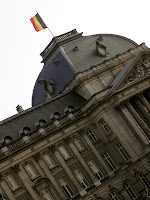



The next day, while walking through the city we found an eclectic flea market (http://brussels.angloinfo.com/information/29/markets.asp) tucked into a square bordered with shops and cafes. People of all ages were rummaging through random treasures such as chandelier pieces and heaps of clothing; trying to find that perfect something. A small band was playing music to add a more vibrant energy as the shopping continued. This bubble of a bounded social space was seen as more of a local market, aimed at bringing local goods and selling them to other locals, not centered around tourists or government officials.
Heading to the cities most visited area; Grand Place in the heart of the city we ran into an unexpected surprise; a parade. As we approached we heard drums and people shouting. We decided to watch and see what they were celebrating. We could see the parade streets away and slowly meander through the city. As the parade advanced, the drums, cheering, and dancing escaladed. More passersby began to clog the street corners and frame the moving celebration. Children, tourists, and couples made up the very diverse demographic that was present. Finally, the parade was close enough to see the people. Their costumes were very abstract garments with everyday items such as cabbage, felt, cardboard, and saran wrap. This bizarre element was seen through the performance pieces, music, and dancing. This displayed the Belgian’s true appreciation for the arts in a very modern way; by moving through the heart of the Capital city in front of historic buildings; showing great pride in their country.
These three very distinct areas strongly connect to the theme of territory and nationalism. Each space was made for certain people whether it be government officials, locals, or tourists. Their purpose was represented through forms of nationalism; whether to influence the country politically or to embrace the country socially. One thing that is quite true of Brussels, is that there are definite sectors of the city, but also sections that combine the extremes of regulation with imagination for a great show of public pride for outsiders to enjoy.




Nice entry, Lauren! You use great sensory detail and strong vocabularly, making it very interesting and easy to follow along with. I like how you incorporated links in your description to refer to other sites, rather than discussing them in length (which could end up making the blog choppy). To get away from the technical stuff, that sounds like an awesome experience! I feel like we would hardly ever see something like that in America, and it's pretty cool that you got to this in Belgium. It also is a great example of what we learned about in classes.
ReplyDelete